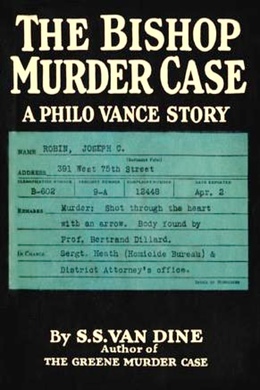
-
EPUB 478 KB
-
Kindle 568 KB
-
Support epubBooks by making a small $2.99 PayPal donation purchase.
This work is available for countries where copyright is Life+70 or less.
Description
When Joseph Cochrane Robin is found murdered in New York’s upper west side accompanied by a note quoting the nursery rhyme “Who Killed Cock Robin”, Philo Vance is called in by District Attorney Markham to help the police track down the murderer. But can Vance solve this complex case before Mother Goose claims any more victims?
334 pages with a reading time of ~5.25 hours (83686 words), and first published in 1928. This DRM-Free edition published by epubBooks, 2015.
Community Reviews
There are currently no other reviews for this book.
Excerpt
Of all the criminal cases in which Philo Vance participated as an unofficial investigator, the most sinister, the most bizarre, the seemingly most incomprehensible, and certainly the most terrifying, was the one that followed the famous Greene murders. The orgy of horror at the old Greene mansion had been brought to its astounding close in December; and after the Christmas holidays Vance had gone to Switzerland for the winter sports. Returning to New York at the end of February he had thrown himself into some literary work he had long had in mind—the uniform translation of the principal fragments of Menander found in the Egyptian papyri during the early years of the present century; and for over a month he had devoted himself sedulously to this thankless task. Whether or not he would have completed the translations, even had his labors not been interrupted, I do not know; for Vance was a man of cultural ardencies, in whom the spirit of research and intellectual adventure was constantly at odds with the drudgery necessary to scholastic creation. I remember that only the preceding year he had begun writing a life of Xenophon—the result of an enthusiasm inherited from his university days when he had first read the Anabasis and the _Memorabilia_—and had lost interest in it at the point where Xenophon’s historic march led the Ten Thousand back to the sea. However, the fact remains that Vance’s translation of Menander was rudely interrupted in early April; and for weeks he became absorbed in a criminal mystery which threw the entire country into a state of gruesome excitement. This new criminal investigation, in which he acted as a kind of amicus curiæ for John F.-X. Markham, the District Attorney of New York, at once became known as the Bishop murder case. The designation—the result of our journalistic instinct to attach labels to every _cause célèbre_—was, in a sense, a misnomer. There was nothing ecclesiastical about that ghoulish saturnalia of crime which set an entire community to reading the “Mother Goose Melodies” with fearful apprehension; and no one of the name of Bishop was, as far as I know, even remotely connected with the monstrous events which bore that appellation. But, withal, the word “Bishop” was appropriate, for it was an alias used by the murderer for the grimmest of purposes. Incidentally it was this name that eventually led Vance to the almost incredible truth, and ended one of the most ghastly multiple crimes in police history. The series of uncanny and apparently unrelated events which constituted the Bishop murder case and drove all thought of Menander and Greek monostichs from Vance’s mind, began on the morning of April 2, less than five months after the double shooting of Julia and Ada Greene. It was one of those warm luxurious spring days which sometimes bless New York in early April; and Vance was breakfasting in his little roof garden atop his apartment in East 38th Street. It was nearly noon—for Vance worked or read until all hours, and was a late riser—and the sun, beating down from a clear blue sky, cast a mantle of introspective lethargy over the city. Vance sprawled in an easy chair, his breakfast on a low table beside him, gazing with cynical, regretful eyes down at the treetops in the rear yard. I knew what was in his mind. It was his custom each spring to go to France; and it had long since come to him to think, as it came to George Moore, that Paris and May were one. But the great trek of the post-war American nouveaux riches to Paris had spoiled his pleasure in this annual pilgrimage; and, only the day before, he had informed me that we were to remain in New York for the summer. For years I had been Vance’s friend and legal adviser—a kind of monetary steward and agent-companion. I had quitted my father’s law firm of Van Dine, Davis & Van Dine to devote myself wholly to his interests—a post I found far more congenial than that of general attorney in a stuffy office—and though my own bachelor quarters were in a hotel on the West Side, I spent most of my time at Vance’s apartment. I had arrived early that morning, long before Vance was up, and, having gone over the first-of-the-month accounts, now sat smoking my pipe idly as he breakfasted. “Y’ know, Van,” he said to me, in his emotionless drawl; “the prospect of spring and summer in New York is neither excitin’ nor romantic. It’s going to be a beastly bore. But it’ll be less annoyin’ than travelin’ in Europe with the vulgar hordes of tourists jostlin’ one at every turn…. It’s very distressin’.”
